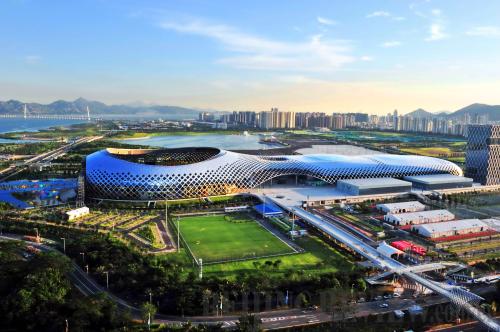|
 |
|
SPRING COCOON: The Shenzhen Bay Sports Center, designed in the shape of a cocoon, was the main stadium for the 26th World University Games and will be used for exhibitions and other cultural events in the future (MA JUN) |
It rained frequently in Shenzhen over the first few days after foreign athletes checked in at the Universiade Village. But the large quantities of rainwater was quickly drained to replenish underground water sources through permeable bricks used to pave the village's grounds.
The Shenzhen Bay Sports Center, which served as the main venue for the event, was equipped with water saving facilities, too. The center is capable of saving 1.07 million cubic meters of water through reclamation annually. More than 2,000 clean energy vehicles, including hybrid double-decker buses, pure electric buses and taxis were deployed during the event, which provided athletes and visitors with convenient and pollution-free services.
The Universiade also promoted urban infrastructure construction in Shenzhen. Before the Universiade, 355 green renovation projects were carried out. After the project, Shenzhen had more parks than any other Chinese city, 824 in total. The length of its subways was extended to 178 km, and as a result, Shenzhen has one of China's four largest subway networks.
"We advocated an economical Universiade. That is, using money rationally on the basis of meeting the basic requirements of the activities," said Wang.
The principle was interpreted into several guidelines for construction, preparation and organization: renovating existing venues and limiting the number of new venues, giving full consideration to after-event use of venues, and borrowing or renting equipment, instead of buying great quantities of gear where possible.
As a result, more than 40 venues were renovated, expanded or installed for temporary use and 22 new ones were built that cut construction budgets by half, Wang said.
The Universiade Village, for example, will become a new campus for Shenzhen Institute of Information Technology after the village is closed on August 26.
Exchange platform
In the past 30 years, Shenzhen has emerged as an international cosmopolitan city from a frontier fishing village thanks to the establishing of the Shenzhen Special Economic Zone in August 1980. With a population of an average age of about 30 years, Shenzhen made the Universiade a festival for young people.
The organizing committee of the event extended the registration deadline to July 12, one month before its opening, when many overseas universities completed their enrollment of new students, in hopes of allowing more freshmen to fulfill their Universiade dream. Even in early August, there were still athletes registering for the competition. By convention, the organizing committee has the right to refuse delayed applications. But, in order to enable a larger number of students to enjoy the grand event, the committee tried to meet demand.
"Up to August 10, there were 7,865 athletes and 4,036 team officials registered for the Universiade," said Huang Guoqiang, Deputy Secretary General of SUOC.
The Universiade is not only a sporting event but also a communication platform for youth worldwide. Young people are curious about cultural differences and thirsty for knowledge of the world outside their national boundaries.
They came from everywhere to compete with each other at venues, converse and make friends in the streets, at the competition arenas or the Universiade Village, and gave brilliant performances at ceremonies.
"Most of our performers were amateurs: A large number of them were from Chinese universities; a dance team was from Duke University in the United States; the theme song was performed by a team of college students from China, Russia and Serbia," said Shi Gang, vice conductor of the Universiade opening and closing ceremonies.
The Universiade held a series of activities to facilitate athletes and students of different nationalities making friends and learning from each other, such as a musical festival on beach, concerts at the Universiade Village, exhibitions and a center for overseas athletes to gain an insight into the Chinese language and culture.
| 